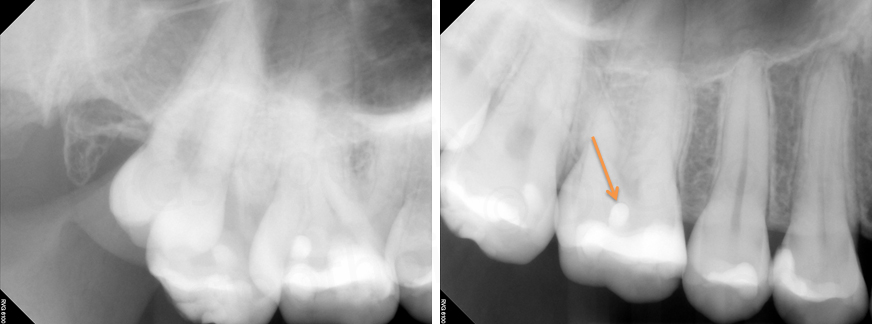Now the answer from Tuesday.
Where is the foreign body (white arrow) in relation to the second molar?
Before starting to use the image shift principle it is important to know/remember two key points
- Images move in the opposite direction from the movement of the source.
- Images of objects farther from the image receptor will move more (aka objects (images) more facial/buccal will appear to move more).
The first thing to do is pick a stationary object that is seen on both radiographs and appears to move in comparison to the foreign body. On these radiographs, we will use the roots of the maxillary right second molar (#2).
The next step is to determine what angle change is obvious between the two radiographs? Positive vertical angle, negative vertical angle or horizontal angle.
The most obvious angle change is the horizontal angle between the two radiographs. Starting with the maxillary right molar periapical radiograph and moving to the maxillary right premolar periapical radiograph, the horizontal angle decreases meaning the source of radiation (tubehead) moves anteriorly. According to point 1 above, this means the images move posterior.
Looking at the second radiograph (maxillary right premolar periapical radiograph), we need to compare the image movement of the foreign body versus the second molar (#2) to see which object moved more posterior following point 2 listed above.
The foreign body appears to be more posterior on the maxillary right premolar periapical radiograph meaning it is farther from the image receptor compared to the second molar (#2).
This gives us an answer of the foreign body being to the facial of the second molar (#2).
SLOB (Same-Lingual, Opposite-Buccal)
We will use the same objects as above (unknown object = foreign body and fixed object = second molar (#2)).
Next, we need to determine which direction we are moving from the maxillary right molar periapical radiograph to the maxillary right premolar periapical radiograph and the answer would be – mesial.
On the maxillary right premolar periapical radiograph determine what direction does the foreign body appear to have moved in relation to the second molar (#2) – distal.
Here is where the acronym comes into play. Did the unknown object move in the SAME direction as the radiographs or in the OPPOSITE direction?
Our answer is – opposite and the acronym states that opposite is buccal, so the foreign body is to the buccal of the second molar (#2).
If you have any questions or comments, please leave them below. Thanks and enjoy!





